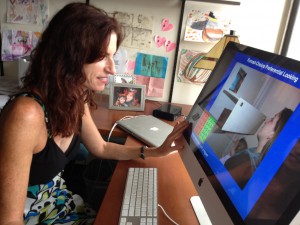Podcast: Play in new window
BOB HIRSHON (host):
Infant synesthesia. I’m Bob Hirshon and this is Science Update.

The adult brain processes visual information in non-overlapping “modules”. There’s a module for color, one for motion, and one for shape. But in adults with synesthesia, there’s crosstalk between two of those modules. For instance, some people see the number “5” as red, or the letter “g” as purple. Only 1 to 2% of adults have synesthesia, but UC San Diego neuroscientist Karen Dobkins thinks we all may be born with it. Her team found that individual babies have consistent preferences for looking at certain shapes when paired with certain colors.
KAREN DOBKINS (UC San Diego):
All infants are born with a lot of crosstalk between the different modules. And presumably, it takes time and development for that crosstalk to go away, to reach the adult-like state where the modules are completely segregated.
HIRSHON:
She says the synesthesia disappears by the time babies are about 8 months old. I’m Bob Hirshon, for AAAS, the science society.
